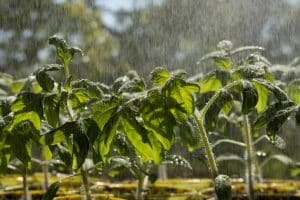
El Niño and your Garden
by Rob Sproule
We’ve all heard about it. For a year the news has told us about a “blob” of warm water gathering in the central Pacific like an invading army. This winter, a powerful El Niño is sweeping across the world, changing weather patterns everywhere it touches. In Alberta we’re fortunate that, while El Niño can bring drought, it doesn’t tend to bring the devastating floods that afflict other parts of the world.
As gardeners, we’re always keeping an eye on weather and El Niño will impact our yards in the year or two ahead. Here is a primer on what to expect in the year ahead.
El Niño 101
The best-known weather pattern in Canada is the result of dominoes that start falling thousands of miles away. First, warm waters gather together over the equatorial Pacific. If you’ve heard forecasters refer to the “blob”, that’s what they’re talking about.
The warm water heats the air over the blob. Hot air is like high octane fuel for the Jet Stream, a fast-flowing and narrow air current in the upper atmosphere. During cold winters, the jet stream dips down into Alberta like a bucket tipping frigid Arctic air all over us. During El Niño, it’s propelled further eastward, which leads to low pressure systems over South Eastern United States and high pressure systems over Western Canada.
While the southern half of the US experiences weather that’s wetter and cooler than normal (good news for California), the northern half and Western Canada experiences warmer weather to the tune of about 3 degrees over normal. It also tends to be drier, with El Niño years closely correlating to droughts on the Prairies. Drought Gardening
What to Expect this Winter
With the polar jet stream, and the frigid Arctic air it carries, displaced further to the north, we’ve enjoyed a warmer than usual first half of winter. The mild weather gives shrubs and perennials an easier time as they hunker down.
While the first half of winter has brought warmer weather, some forecasters are calling for a return to normalcy in February and March. In the balmy conditions, tender plants haven’t built up their cold hardiness and, if the mercury plunges, it could be bad news. Winterizing Made Easy
A lack of snow has accompanied the mild conditions, and while that’s good news for shovelers, it’s a sword of Damocles for tender plants. Snow is like a winter parka for perennials. With snowfall events few and far between, plants will be caught outdoors in t-shirts during potential February cold snaps.
If possible, shovel extra snow onto tender shrubs, perennials, and roses. If they’re near your sidewalk, make the beds your shoveling target. If they’re in the backyard, try to scoop some snow their way.
What to Watch out for after Winter
El Niño’s often last 2 years and, in Western Canada, typically mean dry summers. Just how dry depends on the strength of the El Niño. Our summers in 2006-07 were dry, but the much stronger El Niño of 1997-98 caused a significant drought on the Prairies.
All indications are that this El Niño, nicknamed “Bruce Lee”, will be as strong as 1997-98 and could lead to very dry conditions across the Prairies. In the spring, consider spreading some wood mulch in your beds to reduce evaporation.
Whatever plants go through, so do the bugs. If the weather stays mild, expect protracted summer battles against garden pests and noxious weeds. If a punishing cold snap ensures, expect fewer pests but, potentially, also less flowers.
Many flowering plants, including fruit trees, set their buds before winter and wait for spring temperature cues to blossom. If the mild winter persists and a warm spell in March is followed by a sudden cold snap, we could see a decrease in fruit yield as the buds get nipped as they emerge from protection. Tender flowering and fruiting shrubs/ trees are especially vulnerable.















